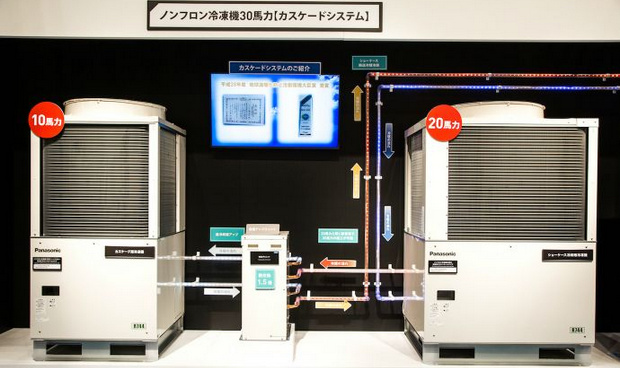Panasonic debuts 30-HP CO2 system

Panasonic is debuting its new 30-HP CO2 cascade system at the 2017 Supermarket Tradeshow in Tokyo.
Panasonic’s new 30-HP system, on display at this week’s Supermarket Tradeshow in Tokyo, aims to solve the two biggest barriers to CO2 adoption for supermarkets in Japan: required refrigeration capacity and strict safety regulations.
Until recently, Panasonic’s maximum capacity offering for CO2 systems was 20 HP, which is insufficient for most large supermarkets. Additionally, Japan’s High Pressure Gas Safety Act limits the size of the CO2 system that can be used.
As a result, supermarkets have lagged far behind smaller convenience stores, which have experienced a huge increase in adoption of CO2 systems in the past couple of years.
The new 30-HP CO2 cascade system aims to help supermarkets moving to CO2 to overcome these barriers.
The system consists of Panasonic’s 20-HP unit, which is linked to a 10-HP unit by what Panasonic has dubbed the ‘capacity increase unit’. The so-called capacity increase unit simply comprises a controller and a heat exchanger, which is used to ‘supercool’ the refrigerant coming from the 20-HP unit.
Linking the two condensing units in this way effectively increases the refrigeration capacity of the gas coming from the 20-HP unit to reach 30-HP.
Higher capacity, same piping
Increasing the refrigeration capacity of the gas itself means none of the existing piping in the store needs to be changed. The same 20-HP piping can be used, minimising installation costs and improving operational reliability.
Development costs were also minimal since the system uses Panasonic’s 10-HP and 20-HP units, which are already being mass-produced – passing on further cost savings to customers.
Supermarkets demand HFC-free
Tachibana says he is encouraged by the growth in demand for CO2 systems from large supermarkets in Japan – demand he has seen grow steadily since the Kigali agreement to phase down HFCs last year.
Supermarkets are increasingly looking for ways to achieve their HFC phase-down goals, ideally with natural refrigerant systems immune from future regulations.
However he is worried that the discontinuation of Japan’s Ministry of Environment (MOE) subsidy for natural refrigerant systems could have a negative effect.
Tachibana says Panasonic – alongside several retailers – will continue to lobby the MOE to reinstate the subsidy for the retail sector.
Panasonic has a lot of standing orders for CO2 systems from retailers waiting for the subsidy to come back into effect. “I should just drop the stack of orders on the MOE’s desk and say, ‘Here, look at this! Look how many customers are demanding CO2!” Tachibana says with a grin.
